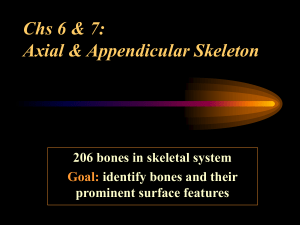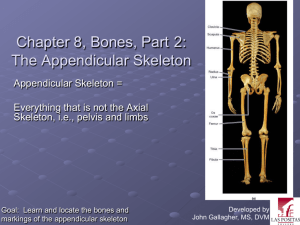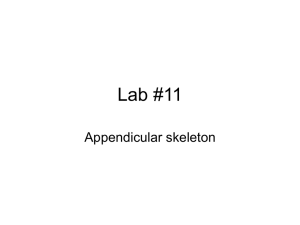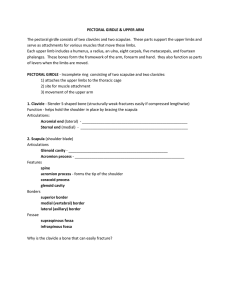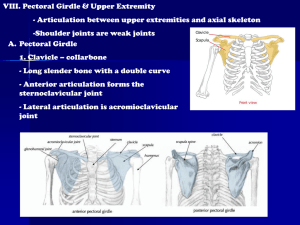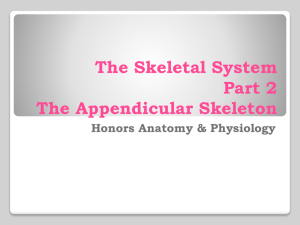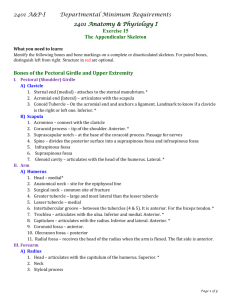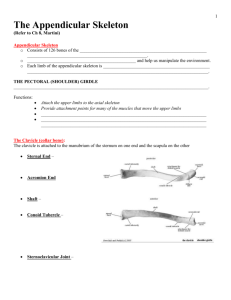The Pectoral Girdle An Introduction to the Appendicular Skeleton
advertisement
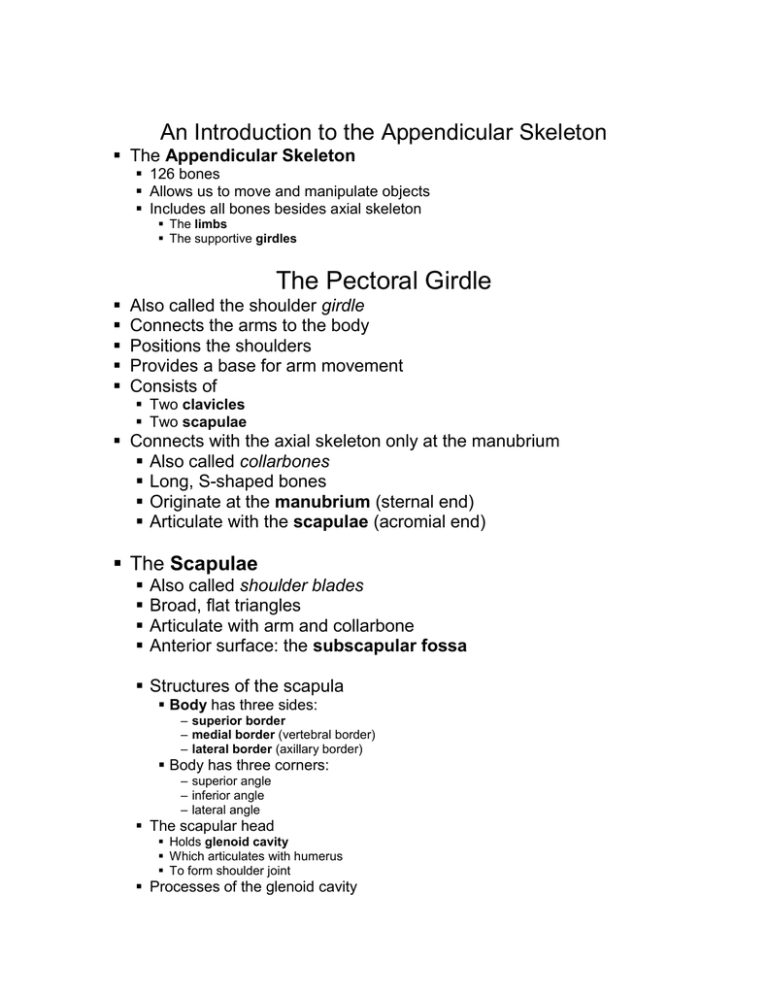
An Introduction to the Appendicular Skeleton The Appendicular Skeleton 126 bones Allows us to move and manipulate objects Includes all bones besides axial skeleton The limbs The supportive girdles The Pectoral Girdle Also called the shoulder girdle Connects the arms to the body Positions the shoulders Provides a base for arm movement Consists of Two clavicles Two scapulae Connects with the axial skeleton only at the manubrium Also called collarbones Long, S-shaped bones Originate at the manubrium (sternal end) Articulate with the scapulae (acromial end) The Scapulae Also called shoulder blades Broad, flat triangles Articulate with arm and collarbone Anterior surface: the subscapular fossa Structures of the scapula Body has three sides: – superior border – medial border (vertebral border) – lateral border (axillary border) Body has three corners: – superior angle – inferior angle – lateral angle The scapular head Holds glenoid cavity Which articulates with humerus To form shoulder joint Processes of the glenoid cavity Coracoid process: – anterior, smaller Acromion: – posterior, larger – articulates with clavicle – at the acromioclavicular joint Posterior features of the scapula Scapular spine: – ridge across posterior surface of body Separates two regions: – supraspinous fossa – infraspinous fossa The Upper Limbs The upper limbs consist of the arms, forearms, wrists, and hands Note: arm (brachium) = 1 bone, the humerus The Humerus Also called the arm The long, upper arm bone Articulates with the pelvic girdle Tubercles of the proximal epiphysis Separated by the intertubercular groove: – greater tubercle: » lateral » forms tip of shoulder – lesser tubercle: » anterior, medial Head: Rounded, articulating surface Contained within joint capsule Anatomical neck: Margin of joint capsule Surgical neck: The narrow metaphysis The Shaft Deltoid tuberosity: – a bulge in the shaft – attaches deltoid muscle Radial groove: – for radial nerve – posterior to deltoid tuberosity The distal epiphysis Medial and lateral epicondyles: – for muscle attachment Condyle of the humerus: – articulates with ulna and radius Articular regions of the condyle Trochlea: – coronoid fossa and olecranon fossa – articulates with ulna Capitulum: – radial fossa – articulates with radius The Forearm (also called the antebrachium) Consists of two long bones Ulna (medial) Radius (lateral) The Ulna The olecranon Superior end of ulna Point of elbow Superior lip of trochlear notch Articulates with trochlea of humerus The coronoid process Inferior lip of trochlear notch The Ulna Articulations with the humerus Forearm extended: – olecranon enters olecranon fossa Forearm flexed: – coronoid process enters coronoid fossa Other articulations Radial notch: – articulates with head of radius – forms proximal radio-ulnar joint Ulnar head: – prominent styloid process – attaches to articular disc between forearm and wrist The Ulna Interosseous membrane A fibrous sheet Connects lateral margin of ulnar shaft to radius The Radius Lateral bone of forearm Disk-shaped radial head above the neck Radial tuberosity below the neck, attaches biceps Articulations of the radius Ulnar notch: – distal end – articulates with wrist and radius Styloid process: – stabilizes wrist joint Eight carpal bones Four proximal carpal bones Four distal carpal bones Allow wrist to bend and twist The Four Proximal Carpal Bones Scaphoid Near styloid process Lunate Medial to scaphoid Triquetrum Medial to lunate bone Pisiform Anterior to triquetrum The Four Distal Carpal Bones Trapezium Lateral Trapezoid Medial to trapezium Capitate Largest Hamate Medial, distal Metacarpal Bones The five long bones of the hand Numbered I–V from lateral (thumb) to medial Articulate with proximal phalanges Phalanges of the Hands (14 total finger bones) Pollex (thumb) Two phalanges (proximal, distal) Fingers Three phalanges (proximal, middle, distal) The Pelvic Girdle Made up of two hip bones (coxal bones) Strong to bear body weight, stress of movement Part of the pelvis Coxal bones Made up of three fused bones Ilium (articulates with sacrum) Ischium Pubis The Pelvic Girdle Coxal Bones The acetabulum Also called the hip socket Is the meeting point of the ilium, ischium, and pubis Is on the lateral surface of the hip bone (coxal bone) Articulates with head of the femur (lunate surface) Acetabular notch A gap in the ridge of the margins of the acetabulum Marks of the Ilium Greater sciatic notch For sciatic nerve Iliac crest Upper brim Iliac fossa Depression between iliac crest and arcuate line The Pelvic Girdle Marks of the Ischium Ischial spine Above lesser sciatic notch Ischial tuberosity Posterior projection you sit on Ischial ramus Meets inferior ramus of pubis Superior ramus Meets pubic tubercle Marks of the Pubis Pubic symphysis Gap between pubic tubercles Padded with fibrous cartilage Obturator foramen Formed by ischial and pubic rami Attaches hip muscles Pectineal line Ridge of superior ramus of pubis Continues to iliac crest as arcuate line (both of the ilium) Coxal Bones Articulations of the pelvic girdle Sacroiliac joint – Articulation of posterior auricular surface of ilium – With the sacrum – Stabilized by ligaments of iliac tuberosity The Pelvis Consists of two coxal bones, the sacrum, and the coccyx Stabilized by ligaments of pelvic girdle, sacrum, and lumbar vertebrae Divisions of the Pelvis True pelvis Encloses pelvic cavity Pelvic brim: – upper edge of true pelvis – encloses pelvic inlet Perineum region: – inferior edges of true pelvis – forms pelvic outlet – perineal muscles support organs of pelvic cavity False pelvis: Blades of ilium above arcuate line Comparing the Male Pelvis and Female Pelvis Female pelvis Smoother and lighter Less prominent muscle and ligament attachments Pelvis modifications for Childbearing – – – – – – enlarged pelvic outlet broad pubic angle (>100°) less curvature of sacrum and coccyx wide, circular pelvic inlet broad, low pelvis ilia project laterally, not upwards The Lower Limbs Functions of the lower limbs Weight bearing Motion Note: leg = lower leg; thigh = upper leg Bones of the Lower Limbs Femur (thigh) Patella (kneecap) Tibia and fibula (leg) Tarsals (ankle) Metatarsals (foot) Phalanges (toes) The Femur The proximal epiphysis Femoral head: – articulates with pelvis at acetabulum – attaches at fovea capitis The neck: – Narrow area between head and trochanters – Joins shaft at angle The proximal epiphysis Trochanters: – greater trochanter and lesser trochanter: » tendon attachments – intertrochanteric line (anterior) and intertrochanteric crest (posterior): » mark edge of articular capsule The shaft Linea aspera: – most prominent ridge of shaft – attaches hip muscles – joins epicondyles The distal epiphysis Medial epicondyle and lateral epicondyle: – above the knee joint Medial condyle and lateral condyle: – separated by intercondylar fossa and patellar surface – form part of knee joint The Patella Also called the kneecap A sesamoid bone Formed within tendon of quadriceps femoris Base attaches quadriceps femoris Apex attaches patellar ligament The Tibia Also called the shinbone Supports body weight Larger than fibula Medial to fibula The proximal epiphysis Medial and lateral tibial condyles: – separated by intercondylar eminence – articulate with medial and lateral condyles of femur Tibial tuberosity: – attaches patellar ligament The shaft Anterior margin: – sharp ridge of shinbone The distal epiphysis Medial malleolus: – medial projection at the ankle The Fibula Attaches muscles of feet and toes Smaller than tibia Lateral to tibia Articulations with tibia Fibula/tibia articulations: – head – inferior tibiofibular joint Interosseous membrane: – binds fibula to tibia Lateral malleolus: – lateral projection of ankle The Ankle Also called the tarsus Consists of seven tarsal bones Bones of the ankle Talus: – carries weight from tibia across trochlea Calcaneus (heel bone): – transfers weight from talus to ground – attaches calcaneal (Achilles) tendon Cuboid: – articulates with calcaneus Bones of the ankle Navicular: – articulates with talus and three cuneiform bones Medial cuneiform Intermediate cuneiform Lateral cuneiform Metatarsal Bones of the Foot Five long bones of foot Numbered I–V, medial to lateral Articulate with toes Phalanges of the foot Phalanges 14 bones of the toes Hallux Big toe or great toe, two phalanges (distal, proximal) Other four toes Three phalanges (distal, medial, proximal) Arches of the Feet Arches transfer weight from one part of the foot to another The longitudinal arch Calcaneal portion: – lateral Talar portion: – medial The transverse arch Formed by a difference in curvature between medial and lateral borders of the foot Individual Skeleton Variation Studying the Skeleton Reveals characteristics Muscle strength and mass (bone ridges, bone mass) Medical history (condition of teeth, healed fractures) Sex and age (bone measurements and fusion) Body size
